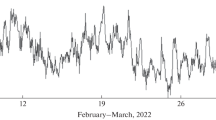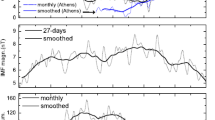Abstract
The two components of the solar diurnal variation observed with two detectors characterized by linearly independent coupling functions have been used to estimate the free space anisotropy vector during the period 1968–1995 using the least-squares method (LSM). The values of Rcshow ∼20-year magnetic cycle with the lowest values at solar activity minima for positive polarity (qA>0). A good correlation is obtained between Rcand the IMF magnitude. The amplitude of the radial anisotropy (AR) shows ∼20-year magnetic cycle with the highest values around solar activity minima for qA>0 (1975–1976 and 1995), whereas that of the east-west (Aφ) is minimum. This results in shifting the anisotropy vector to the earliest hours. The amplitude of the anisotropy is high around solar maxima and low around solar minima. It is also enhanced during the declining phase of solar activity (1971, 1984–1985, and 1991). Our results of the anisotropy have been used to calculate the cosmic-ray radial and transverse gradients. The value of the radial gradient exhibits a magnetic polarity dependence as well, with larger value during qA<0 than during qA>0.
Similar content being viewed by others
References
Ahluwalia, H. S.: 1988a, Planetary Space Sci. 36, 1451.
Ahluwalia, H. S.: 1988b, Geophys. Res. Letters 15, 287.
Ahluwalia, H. S.: 1992, Geophys. Res. Letters 19, 633.
Ahluwalia, H. S.: 1993, J. Geophys. Res. 98, 11 513.
Ahluwalia, H. S.: 1994, J. Geophys. Res. 99, 23 515.
Ahluwalia, H. S.: 1996, J. Geophys. Res. 101, 13 549.
Ahluwalia, H. S. and Dorman, L. I.: 1997, J. Geophys. Res. 102, 17 433.
Ahluwalia, H. S. and Ericksen, J. H.: 1970, Acta Phys. Acad. Sci. Hung. Suppl. 29(2), 139.
Ahluwalia, H. S. and Fikani, M. M.: 1997, 25th Int. Cosmic-Ray Conf. 2, 125.
Ahluwalia, H. S. and Riker, J. F.: 1987a, Planetary Space Sci. 35, 39.
Ahluwalia, H. S. and Riker, J. F.: 1987b, Planetary Space Sci. 35, 45.
Ahluwalia, H. S. and Sabbah, I.: 1993, Planetary Space Sci. 41, 105.
Axford, W. I.: 1965, Planetary Space Sci. 13, 115.
Bieber, J. W. and rChen, J.: 1991, Astrophys. J. 372, 301.
Chahine, M.: 1972, J. Atmospheric Sci. 29, 741.
Dorman, L. I.: 1974, Cosmic-ray Variations and Space Explorations, North-Holland, Amsterdam, pp. 252.
El-Raey, M. and Sabbah, I.: 1984, J. Geophys. Res. 89, 5643.
Fujii, Z. and Ueno, H.: 1990, 21th Int. Cosmic-Ray Conf. 6, 314.
Fujimoto, K., Inoue, A., Murakami, K., and rNagashima, K.: 1984, Coupling Coefficients of Cosmic-Ray Daily Variations for Meson Telescopes, Rep.Cosmic-Ray Res. Lab., Nagoya University, No. 9.
Kota, J. and Jokipii, J. R.: 1983, Astrophys. J. 265, 573.
Kudo, S., Mori, S., Swinson, D. B., Yasue, S., and Ryu, J. Y.: 1987, 20th Int. Cosmic-Ray Conf. 4, 140.
Murakami, K., Sagisaka, S., Mishima, K. Y., Inoue, A., and rNagashima, K.: 1981, Response Functions for Cosmic-Ray Muon Observed at Various Locations, Rep. 6, Cosmic-Ray Research Laboratory, Nagoya University, Nagoya, Japan.
Parker, E. N.: 1964, Planetary Space Sci. 12, 1723.
Sabbah, I.: 1994, Egyp. J. Phys. 25, 123.
Sabbah, I.: 1996, J. Geophys. Res. 101, 2485.
Sabbah, I.: 1999, Solar Phys. 186, 413.
Sabbah, I. and Potgieter, M. S.: 1995, 24th Int. Cosmic-Ray Conf. 4, 584.
Sabbah, A., Darwish, and rBishara, A.: 1998, Solar Phys. 181, 469.
Stern, D. J.: 1964, Planetary Space Sci. 12, 279.
Ueno, H., Fujii, Z., Mori, S., Morishita, I., and rNagashima, K.: 1985, 19th Int. Cosmic-Ray Conf. 5, 147.
Yasue, S., Mori, S., Sakakibara, S., and Nagashima, K.: 1982, Coupling Coefficients of Cosmic-Ray Daily Variations for Neutron Monitor Stations, Rep. Cosmic-Ray Res. Lab., Nagoya University, No. 7.
Author information
Authors and Affiliations
Rights and permissions
About this article
Cite this article
Sabbah, I. Magnetic Cycle Dependence of the Cosmic-Ray Diurnal Anisotropy. Solar Physics 188, 403–417 (1999). https://doi.org/10.1023/A:1005113317072
Issue Date:
DOI: https://doi.org/10.1023/A:1005113317072




